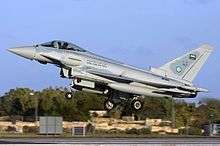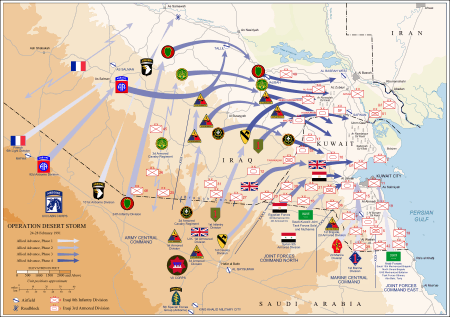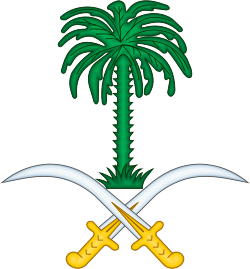Armed Forces of Saudi Arabia
The Saudi Arabian Armed Forces (Arabic: القُوَّات العَرَبِيَّة السُّعُودِيَّة المُسَلَّحَة) or SAAF (also known as the Royal Saudi Armed Forces) are the military forces of Saudi Arabia. It consists of the Saudi Arabian Army, the Royal Saudi Navy, the Royal Saudi Air Force, the Royal Saudi Air Defense, and the Royal Saudi Strategic Missile Force. The King of Saudi Arabia is the commander-in-chief of the Armed Forces and forms military policy with the Ministry of Defense and the Ministry of Interior. The five Armed Forces are among eight military forces of Saudi Arabia, with the others including the Saudi Arabian National Guard (under the administrative control of the Ministry of National Guard), the Saudi Royal Guard Regiment and Saudi Arabian Border Guards. In addition, there is also the General Intelligence Presidency which is the main intelligence service.
| Saudi Arabian Armed Forces | |
|---|---|
| القُوَّات العَرَبِيَّة السُّعُودِيَّة المُسَلَّحَة | |
 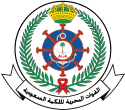 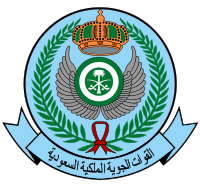 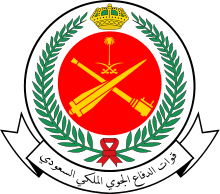 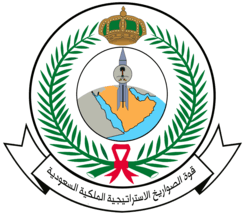 Emblems of the Armed Forces | |
| Founded | 1745[1] |
| Current form | General Staff (MoD)[2] |
| Service branches | |
| Headquarters | Riyadh |
| Leadership | |
| Supreme commander | Prince Mohammad Al Saud |
| Commander-in-chief | General Fayyadh Al Ruwaili |
| Manpower | |
| Military age | 17[3] |
| Conscription | No[4] |
| Active personnel | 227,000 (ranked 10) |
| Deployed personnel | |
| Expenditures | |
| Budget | US$100.4 billion (3rd)[10] |
| Percent of GDP | 8.8% (F.Y 2018 est.)[11] |
| Industry | |
| Domestic suppliers | |
| Foreign suppliers | |
| Related articles | |
| History | |
| Ranks | KSA military ranks |
The Armed Forces are one of the best-funded in the world.[12] Saudi Arabia has the world's third largest defense budget.[10]
International Institute for Strategic Studies estimates in 2017 listed a total of 127,000 personnel (75,000 RSLF; 13,500 Navy; 20,000 Air Force; 16,000 Air Defence; and Strategic Missile Forces 2,500).[13] The RSLF figure is quite possibly inflated. The National Guard, with 100,000 personnel, many tribal and only-available-on-callup, and 24,500 paramilitary personnel round out the figures. The IISS Military Balance lists reserve personnel when reliable figures are available, but did not list any reserve personnel for Saudi Arabia.
History
The first steps towards building an institutionalised armed force for Saudi Arabia began in the 1940s, when Saudi regulars numbered perhaps 1,000–1,500, Gaub saying that officers mostly came from the Ottoman troops who had served the Sharif of Mecca before his being expelled in 1924.[14] A Ministry of Defence was created in 1944; a military school founded in Taif, and the United Kingdom began efforts to try to build a professional force. After the failure of this UK programme, a subsequent U.S. programme which ran from 1951 also failed to reach its objective (the creation for three to five Regimental Combat Teams. Growth of the armed forces was slow, to some 7,500–10,000 by 1953, and that growth halted towards the end of the 1950s because of political factors (the Free Officers in Egypt; two plots by senior officers; and internal Saudi power struggles).
In 2019, the government of Saudi Arabia stated that women can start working in the military. In the past they could only work in police. [15]
Military services
The armed forces are mainly the responsibility of the Ministry of Defense and Aviation, which also oversees the construction of civilian airports as well as military bases, and meteorology departments.
Crown Prince Sultan bin Abdulaziz was Saudi Arabia's Minister of Defence and Aviation from 1962 to 2011. The vice minister, Abdulrahman bin Abdulaziz, was his full brother and served until November 2011. His oldest son, Khalid bin Sultan, was appointed assistant minister in 2001 and was in office until April 2013.
In 1987, members of the air force, army, and navy used to be mainly recruits from groups of people without a strong identity from the Nejd tribal system and people from urban areas.[16]
Defense spending
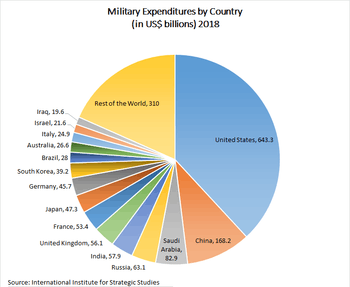
Spending on defense and security has increased significantly since the mid-1990s and was about US$67 billion in 2013. Saudi Arabia ranks among the top five nations in the world in government spending for its military, representing about 9% of GDP in 2013. Its modern, high-technology arsenal makes Saudi Arabia among the world's most densely armed nations, with its military equipment being supplied primarily by the United States, France, and Britain.[17] According to SIPRI, in 2010–14 Saudi Arabia became the world's second largest arms importer, receiving four times more major arms than in 2005–2009. Major imports in 2010–14 included 45 combat aircraft from the United Kingdom, 38 combat helicopters from the U.S., 4 tanker aircraft from Spain and over 600 armored vehicles from Canada. Saudi Arabia has a long list of outstanding orders for arms, including 27 more combat aircraft from the United Kingdom, 154 combat aircraft from the U.S. and a large number of armoured vehicles from Canada.[18]
The United States sold more than $80 billion in military hardware between 1951 and 2006 to the Saudi military.[19] In comparison, the Israel Defense Forces received $53.6 billion in U.S. military grants between 1949 and 2007.[20] On 20 October 2010, U.S. State Department notified Congress of its intention to make the biggest arms sale in American history—an estimated $60.5 billion purchase by the Kingdom of Saudi Arabia. The package represented a considerable improvement in the offensive capability of the Saudi armed forces.[21] The United States emphasized that the arms transfer would increase "interoperability" with U.S. forces. In the Persian Gulf War, having U.S.-trained Saudi Arabian forces, along with military installations built to U.S. specifications, allowed the U.S. military to deploy in a comfortable and familiar battle environment. This new deal would increase these capabilities, as an advanced American military infrastructure is about to be built.[22] The U.S. government was also in talks with Saudi Arabia about the potential sale of advanced naval and missile-defense upgrades.[23]
The United Kingdom has also been a major supplier of military equipment to Saudi Arabia since 1965.[24] Since 1985, the United Kingdom has supplied military aircraft—notably the Tornado and Eurofighter Typhoon combat aircraft—and other equipment as part of the long-term Al-Yamamah arms deal estimated to have been worth £43 billion by 2006 and thought to be worth a further £40 billion.[25]
Canada recently won a contract worth at least US$10 billion to supply the Saudi Arabian army with armored military vehicles.[26]
Service branches
Army


The army's main equipment consists of a combination of French- and U.S.-made armored vehicles: 315 M–1A2 Abrams, 290 AMX–30, and 450 M60A3 main battle tanks; 300 reconnaissance vehicles; 570+ AMX–10P and 400 M–2 Bradley armored infantry fighting vehicles; 3,000+ M113 and 100 Al-Fahd armored personnel carriers, produced in Saudi Arabia; 200+ towed artillery pieces; 110 self-propelled artillery pieces; 60 multiple rocket launchers; 400 mortars; 10 surface-to-surface missiles; about 2,000 antitank guided weapons; about 200 rocket launchers; 450 recoilless launchers; 12 attack helicopters; 50+ transport helicopters; and 1,000 surface-to-air missiles.[17]
In 1996 Saudi Arabia had military cities in the northeast, the King Khalid Military City, at Tabuk, at Dharhran, and at Abha in the southwest. There was a 1996 report that construction of a military city at Jizan, orientated toward Yemen, had begun with Defence Minister Prince Sultan pouring the first concrete on 8 May 1996.[27]
The Library of Congress Country Study for Saudi Arabia, issued in 1992, noted that "[t]he army has been chronically under strength, in the case of some units by an estimated 30 to 50 percent. These shortages have been aggravated by a relaxed policy that permitted considerable absenteeism and by a serious problem of retaining experienced technicians and non-commissioned officers.[28]
Royal Navy


The navy's inventory includes 11 principal surface combatants, 65 patrol and coastal combatants, 7 mine warfare vessels, 8 amphibious craft, and 7 support and miscellaneous craft. Naval aviation forces have 19 helicopters (armed) serving in naval support.[17]
Royal Air Forces

As of 2011, Saudi Arabia has around 300 combat aircraft. The kingdom's combat aircraft are newly acquired Typhoons and upgraded Tornado IDS, F-15 Eagle and F-15E Strike Eagle fighter planes. Saudi Arabia has a further 80+ F-15 Eagles on order and an option to buy another 72 Typhoons.
Royal Air Defense
.jpg)

The system equipment comprises 17 General Electric AN/FPS-117 long-range 3D radars, 6 Northrop Grumman AN/TPS-43 tactical radars, and Raytheon Improved HAWK air defence missile system.[29]
Royal Strategic Forces

But RSSMF certainly has one advanced Al-Watah ballistic missile base (found on the satellite images) in the rocky central part of Saudi Arabia, some 200 km south-west of the capital city Riyadh.[32] Two other bases include Al Sulayyil ballistic missile base (the older base located 450 km southwest of Riyadh) and Al Jufayr base (placed 90 km south of Riyadh) share many similarities, suggesting that they share the same role.
Guard Forces
Royal Guard
The Saudi Arabian Royal Guard Regiment is one of the more visible units . Originally an independent military force, the Royal Guards were incorporated into the Army in 1964. However, the Royal Guards still retained their unique mission of protecting the House of Saud. Units of the Royal Guard protect the King of Saudi Arabia at all times.[33]
The Royal Guards report directly to the king and for security reasons maintain a separate communications network from the regular Army.
Members of the Royal Guard Regiment often wore the flowing white thaub (robe) and white kaffiyah and qutrah (traditional Arab headgear of skullcap and scarf). Royal Guardsmen wear bright green berets when in conventional uniforms.
National Guard
The Saudi Arabian National Guard is independent of the Ministry of Defense and Aviation and is organized into three mechanized infantry brigades, five infantry brigades, and one ceremonial cavalry squadron.
The Saudi Arabian National Guard is not a reserve but a fully operational front-line force and originated out of Abdul Aziz's tribal military-religious force, the Ikhwan. Its modern existence, however, is attributable to it being effectively Salman's private army since the 1960s and, unlike the rest of the armed forces, is independent of the Ministry of Defense. The SANG has been a counterbalance to the Sudairi faction in the royal family; Salman of Saudi Arabia, the king, is one of the so-called "Sudairi Seven" and controls the remainder of the armed forces. The SANG is equipped with 100 Saudi-manufactured Al-Fahd infantry fighting vehicles.[34] It has been strengthened by the purchase of US$1 billion worth of new armored vehicles from Canada.
Border Guard
Armed Forces Medical Service
Armed Forces Medical Service of Saudi Arabia provides medical services to all members of the Armed Forces. It is lead by a Director General and is responsible for 24 military hospitals across Saudi Arabia.[35]
The service operates aero lift operations with their own fleet of aircraft:
- Lockheed Martin VC-130H flying hospital
- Bell 212 helicopter
- Aerospatile Dolphin 365N helicopter
- Sikorsky UH60 Desert Hawk helicopter
- Learjet
- Gulfstream G3
- Gulfstream G4
- Gulfstream G5
Recent military operations
Persian Gulf War
When Iraq invaded Saudi Arabia's northern neighbor Kuwait in 1990, Saudi Arabia immediately requested the deployment of U.S. troops within the country to deter further aggression. Saudi forces participated in the subsequent Operation Desert Storm: Saudi pilots flew more than 7,000 sorties and Saudi troops took part in the battles around the Saudi town of Ras al-Khafji.[36]
Operation Southern Watch
Since the Persian Gulf War, the United States stationed 5,000 troops in Saudi Arabia, a figure that rose to 10,000 during the 2003 conflict in Iraq.[37] Operation Southern Watch enforced the no-fly zones over southern Iraq set up after 1991, as well, the country's oil exports through the shipping lanes of the Persian Gulf are protected by the United States Fifth Fleet based in Bahrain. It was conducted by Joint Task Force Southwest Asia (JTF-SWA) with the mission of monitoring and controlling airspace south of the 32nd Parallel (extended to the 33rd Parallel in 1996) in Iraq, following the 1991 Persian Gulf War until the 2003 invasion of Iraq.
This was one of the stated motivations behind the September 11 attacks,[37] as well as the Khobar Towers bombing.[38] Bin Laden interpreted the Islamic prophet, Muhammad as banning the "permanent presence of infidels in Arabia".[39]
Shia insurgency in Yemen
On 5 November 2009, the Royal Saudi Land Forces launched a sweeping ground offensive against Yemen's Shiite Houthi rebels after they crossed the Saudi border in order to outflank the Yemeni Army, which had launched a military campaign against the Houthis to control and pacify the northern Yemeni mountains, and killed two Saudi border guards. The Saudi forces relied heavily on air power and artillery to soften the rebels without risking their men. The Saudi Army lost 133 soldiers in the fighting against the rebels, with most of the casualties occurring when ground forces tried to move into areas that had been softened by shelling that "raised alarms across the Sunni Arab world about the possibility that Iran might be supporting the Yemeni rebels".[40]
Officer ranks
| Equivalent NATO Code | OF-10 | OF-9 | OF-8 | OF-7 | OF-6 | OF-5 | OF-4 | OF-3 | OF-2 | OF-1 | OF(D) and student officer | |||||||||||||||||||||||||
|---|---|---|---|---|---|---|---|---|---|---|---|---|---|---|---|---|---|---|---|---|---|---|---|---|---|---|---|---|---|---|---|---|---|---|---|---|
(Edit) |
No equivalent |  |
 |
 |
 |
 |
 |
 |
 |
 |
 |
 | ||||||||||||||||||||||||
| Fariq Awwal (فريق أول) |
Fariq (فريق) |
Liwa (لواء) |
Amid (عميد) |
Aqid (عقيد) |
Muqaddam (مقدم) |
Raid (رائد) |
Naqib (نقيب) |
Mulazim Awwal (ملازم أول) |
Mulazim (ملازم) |
Officer cadet | ||||||||||||||||||||||||||
Enlisted ranks
| Enlisted Ranks | |||||||||||
|---|---|---|---|---|---|---|---|---|---|---|---|
| Private | Private first class | Corporal | Vice sergeant | Sergeant | Sergeant first class | Master sergeant | |||||
Military industry
The vast majority of Saudi Arabia's military equipment is imported from European and North American suppliers.[17] However, the Al-Fahd Infantry fighting vehicle and the Al-Faris 8–400 armored personnel carrier, used by Saudi land forces, were manufactured by the Abdallah Al Faris Company for Heavy Industries, based in Dammam. Also, Al-Kaser and Al-Mansour armored vehicles and the Al-Masmak MRAP which has achieved very high protection, all are Saudi-made[41][42] Ashibl 1 and Ashibl 2 are Saudi-made armored vehicles used by the Royal Saudi Land Forces and the kingdom's most elite special operations units of Battalion 85. Saudi Arabia has also recently unveiled the new Tuwaiq MRAP[43][44]
Saudi Arabian Military Industries signed a Memorandum of Understanding with ROSOBORONEXPORT for the local production of the 9M133 Kornet-EM anti-tank guided missile (ATGM) system, the TOS-1A advanced multiple rocket launcher and AGS-30 automatic grenade launchers with grenades and Kalashnikov AK-103.[45]
See also
References
Citations
- Sir James Norman Dalrymple Anderson. The Kingdom of Saudi Arabia. Stacey International, 1983. p. 77.
- Hertog, Steffen (2007). "Shaping the Saudi state: Human agency's shifting role in the rentier state formation" (PDF). International Journal of Middle East Studies. 39 (4): 539–563. doi:10.1017/S0020743807071073. Archived (PDF) from the original on 2 October 2013. Retrieved 17 April 2012.
- "The World Factbook". The World Factbook. Langley, Virginia: Central Intelligence Agency. Archived from the original on 22 March 2016. Retrieved 6 April 2016.
- "Middle East: Saudi Arabia". The World Factbook. Langley, Virginia: Central Intelligence Agency. 17 October 2018. Archived from the original on 28 May 2010. Retrieved 21 October 2018.
- Shrivastava, Sanskar (15 March 2011). "Saudi Arabian Troops Enter Bahrain, Bahrain Opposition Calls It War". The World Reporter. Archived from the original on 18 March 2011. Retrieved 15 April 2011.
- Felicia Schwartz; Hakim Almasmari; Asa Fitch (26 March 2015). "Saudi Arabia Launches Military Operations in Yemen". The Wall Street Journal.
- Henderson, Simon. "Bahrain's Crisis: Saudi Forces Intervene". Washington Institute. Archived from the original on 4 April 2016. Retrieved 19 March 2016.
- "Saudi Arabia launches airstrikes in Yemen". CNN. 26 March 2015. Archived from the original on 26 March 2015. Retrieved 26 March 2015.
- "Djibouti welcomes Saudi Arabia plan to build a military base". middleeastmonitor.com. Retrieved 28 November 2017.
- "IISS Military Balance 2020".
- Tian, Nan; Fleurant, Aude; Kuimova, Alexandra; Wezeman, Pieter D.; Wezeman, Siemon T. (28 April 2019). "Trends in World Military Expenditure, 2018" (PDF). Stockholm International Peace Research Institute. Retrieved 30 April 2019.
- " Archived 2 January 2016 at the Wayback Machine, 31 December 2015,
- IISS Military Balance 2017, 401.
- Gaub, Florence (2017). Guardians of the Arab State: When militaries intervene in politics, from Iraq to Mauritania. Oxford University Press. p. 156. ISBN 9781849046480.
- "Saudi women can now join the armed forces". Khaleej Times. 3 October 2019. Retrieved 16 May 2020.
- Mackey, Sandra (2002). The Saudis: Inside the Desert Kingdom. W.W. Norton. p. 207. ISBN 9780393324174.
- "Country Profile: Saudi Arabia" Archived 16 January 2011 at the Wayback Machine, September 2006, United States Library of Congress
- "Trends in International Arms Transfer, 2014". Stockholm International Peace Research Institute. Archived from the original on 19 March 2015. Retrieved 18 March 2015.
- "Saudi Arabia" Archived 11 November 2010 at the Wayback Machine, Federation of American Scientists
- Pierre Tristam Middle East Issues Expert. "U.S. Arms Sales to Saudi Arabia". Middleeast.about.com. Archived from the original on 12 January 2011. Retrieved 21 November 2015.
- "Arms for the King and His Family: The U.S. Arms Sale to Saudi Arabia". Jerusalem Center For Public Affairs. Archived from the original on 5 December 2010. Retrieved 25 December 2014.
- Anthony H. Cordesman (17 September 2010). "US-Saudi Security Cooperation, Impact of Arms Sales". Saudi-U.S. Relations Information Service. Archived from the original on 13 January 2011. Retrieved 16 November 2010.
- "Saudi Arms Deal Advances" Archived 16 November 2017 at the Wayback Machine, Wall Street Journal
- Gardner, Charles (1981). British Aircraft Corporation. A history by Charles Gardner. B.T. Batsford Ltd. pp. 224–249. ISBN 978-0-7134-3815-4.
- O'Connell, Dominic (20 August 2006). "BAE cashes in on £40bn Arab jet deal". The Sunday Times. London. Archived from the original on 7 September 2008. Retrieved 22 August 2006.
- "Saudi Arabia, Canada Sign Landmark US$10B Military Vehicle Deal". HuffPost. 14 February 2014. Archived from the original on 19 January 2018. Retrieved 18 January 2018.
- James Bruce, "Saudis building military city on Yemen border", Jane's Defence Weekly, 15 May 1996, p.3
- Metz, Helen C (1992). Area Handbook Series: Saudi Arabia. A Country Study. Washington DC: FEDERAL RESEARCH DIV, Library of Congress. p. 253. ISBN 9780844407913.
- "Peace Shield (Saudi Arabia), Systems" Archived 28 September 2010 at the Wayback Machine, Jane's Military Communications, 5 July 2005. Retrieved 23 January 2012
- "Saudi Arabia unveils part of strategic missile force – a deterrent move against Iran?". 2 May 2014. Retrieved 16 May 2020.
- SinoDefence "DongFeng 3 (CSS-2) Intermediate-Range Ballistic Missile" Archived 14 August 2013 at the Wayback Machine, sinodefence, 27 February 2009.
- Sean O'Connor, "Saudi ballistic missile site revealed" Archived 14 July 2013 at the Wayback Machine, IHS Jane's Defence Weekly, 10 July 2013.
- Metz, Helen C. "Area Handbook Series: Saudi Arabia. A Country Study." Federal Research Division, Library of Congress, Washington DC., 1992, 254.
- "Al Fahd – Wheeled Armoured Reconnaissance/Personnel Carrier". Army Technology. Archived from the original on 21 December 2010. Retrieved 30 August 2010.
- "SAUDI ARABIA, KINGDOM OF". militar-medicine.com. Retrieved 16 May 2020.
- "Saudi Arabia". Encyclopædia Britannica. Archived from the original on 19 December 2013. Retrieved 25 December 2014.
- "US pulls out of Saudi Arabia". BBC News. 29 April 2003. Archived from the original on 6 January 2010. Retrieved 29 November 2009.
- Plotz, David (2001) "What Does Osama Bin Laden Want?" Archived 12 November 2007 at the Wayback Machine, Slate
- Bergen, Peter L. (2001). Holy War Inc. Simon & Schuster. p. 3.
- Robert F. Worth (26 October 2010). "Saudi Border With Yemen Is Still Inviting for Al Qaeda". The New York Times. Archived from the original on 24 July 2016. Retrieved 24 February 2017.
- "Al-Masmak Masmak Nyoka Mk2 MRAP Mine Resistant Armored Personnel Carrier technical data sheet". Army Recognition. Archived from the original on 21 June 2014. Retrieved 25 December 2014.
- "Photos & Videos". arabic-military.com. Archived from the original on 28 October 2014. Retrieved 25 December 2014.
- "Saudi Made "Tuwaiq" MRAP Unvieled in IDEX 2013". Archived from the original on 28 October 2014. Retrieved 25 December 2014.
- "Saudi Twaiq Mine-Resistant Ambush Protected (MRAP)". Global Military Review. Archived from the original on 22 December 2014. Retrieved 25 December 2014.
- "Saudi Arabia signs agreement to manufacture Russian weapons locally". Al Arabiya. Archived from the original on 6 October 2017. Retrieved 6 October 2017.
Sources
- China, Russia, Saudi Arabia Boosted Defense Most as U.S. Cut http://bloom.bg/1OqdP38
Further reading
- "Foreign Military Sales, Foreign Military Construction Sales and Military Assistance Facts as of September 2003," Published by Deputy for Operations and Administration, Business Operations/Comptroller, DSCA, Department of Defense
- "'Chief dismissed in reshuffle,' – Chief of General Staff Lt Gen Mohammed Saleh Al-Hammad replaced by Saleh Ibn Ali Al-Mohaya," Jane's Defence Weekly, 9 October 1996, p. 23
- C. A. Woodson, "Saudi Arabian Force Structure Development in a Post Gulf War World", Foreign Military Studies Office, June 1998, https://web.archive.org/web/20120306115652/http://fmso.leavenworth.army.mil/
